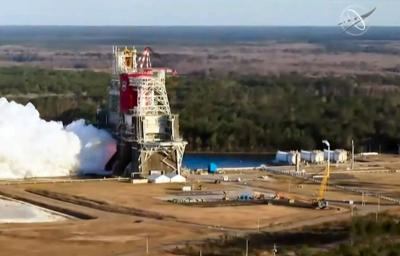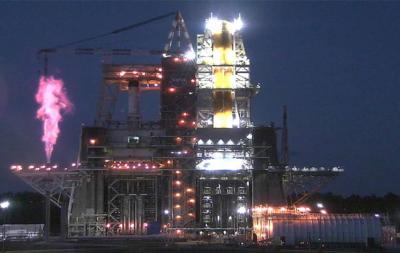Data and Inspections Indicate Core Stage in Good Condition
The Space Launch System (SLS) rocket Green Run team has reviewed extensive data and completed preliminary inspections that show the rocket’s hardware is in excellent condition after the Green Run test that ignited all the engines at 5:27 p.m. EST at NASA’s Stennis Space Center near Bay St. Louis, Mississippi. After analyzing initial data, the team determined that the shutdown after firing the engines for 67.2-seconds on Jan.16 was triggered by test parameters that were intentionally conservative to ensure the safety of the core stage during the test.

These preprogrammed parameters are designed specifically for ground testing with the flight hardware that will fly NASA’s Artemis I mission to ensure the core stage’s thrust vector control system safely moves the engines. There is a thrust vector control (TVC) system that gimbals, or pivots, each engine, and there are two actuators that generate the forces to gimbal each engine. The actuators in the TVC system are powered by Core Stage Auxiliary Power Units (CAPU). As planned, the thrust vector control systems gimbaled the engines to simulate how they move to direct thrust during the rocket’s ascent.
During gimballing, the hydraulic system associated with the core stage’s power unit for Engine 2, also known as engine E2056, exceeded the pre-set test limits that had been established. As they were programmed to do, the flight computers automatically ended the test. The specific logic that stopped the test is unique to the ground test when the core stage is mounted in the B-2 test stand at Stennis. If this scenario occurred during a flight, the rocket would have continued to fly using the remaining CAPUs to power the thrust vector control systems for the engines.
During the test, the functionality of shutting down one CAPU and transferring the power to the remaining CAPUs was successfully demonstrated. This gimballing test event that resulted in shutting down the CAPU was an intentionally stressing case for the system that was intended to exercise the capabilities of the system. The data is being assessed as part of the process of finalizing the pre-set test limits prior to the next usage of the core stage.

Throughout the hot fire, all four engines performed as expected. While the test planned to fire the four engines for about 8 minutes, the team still achieved several objectives during the shorter firing. They repeated the wet dress rehearsal, once again filling the tanks with more than 700,000 gallons of propellant with some added modifications to procedures to ensure proper thermal conditioning of the engines. They successfully pressurized the propellant tanks, completed the countdown, and ignited the engines for the first time. The engines reached their full power of 109 percent producing 1.6 million pounds of thrust, just as they will during the Artemis I launch.
Initial data indicate the sensor reading for a major component failure, or MCF, that occurred about 1.5 seconds after engine start was not related to the hot fire shutdown. It involved the loss of one leg of redundancy prior to T-0 in the instrumentation for Engine 4, also known as engine number E2060. Engine ignition begins 6 seconds prior to T-0, and they fire in sequence about 120 milliseconds apart. Test constraints for hot fire were set up to allow the test to proceed with this condition, because the engine control system still has sufficient redundancy to ensure safe engine operation during the test. The team plans to investigate and resolve the Engine 4 instrumentation issue before the next use of the core stage.
Engineers also continue to investigate reports of a “flash” around the engines. A visual inspection of the thermal blankets that protect the engine show signs of some exterior scorching, which was anticipated due to their proximity to engine and CAPU exhaust. Sensor data indicate temperatures in the core stage engine section were normal. Both observations are an early indication the blankets did their job and protected the rocket from the extreme heat generated by the engines and CAPU exhaust.
Data analysis is continuing to help the team determine if a second hot fire test is required. The team can make slight adjustments to the thrust vector control parameters and prevent an automatic shut down if they decide to conduct another test with the core stage mounted in the B-2 stand.
 Aero-News: Quote of the Day (11.26.25)
Aero-News: Quote of the Day (11.26.25) ANN's Daily Aero-Term (11.26.25): Takeoff Hold Lights (THL)
ANN's Daily Aero-Term (11.26.25): Takeoff Hold Lights (THL) ANN's Daily Aero-Linx (11.26.25)
ANN's Daily Aero-Linx (11.26.25) Airborne Affordable Flyers 11.20.25: Sonex $$$, SnF 26 MOSAIC DAY, P. Ponk STCs
Airborne Affordable Flyers 11.20.25: Sonex $$$, SnF 26 MOSAIC DAY, P. Ponk STCs ANN's Daily Aero-Linx (11.27.25)
ANN's Daily Aero-Linx (11.27.25)




